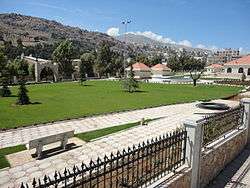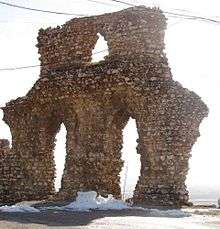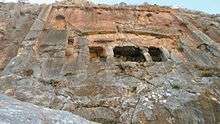Qabb Ilyas
Qabb Ilyas (Arabic: قب الياس; ALA-LC: Qab Ilyās / Lebanese Arabic: [Abblyes]) also spelled Kab Elias, Qab Elias, Qob Elias, Qoub Elias) is a municipality in Zahle District, in eastern Lebanon. Qabb Ilyas is 15 kilometers from Zahleh and 45 kilometers (28 miles) from the Lebanese capital Beirut. Its average elevations is 950 meters (3,120 feet) above sea level. Its area is approximately 32 km².[1] Qabb Ilyas is the third largest city in the Beqaa Valley, after Zahleh and Baalbek in terms of area size and geography. The majority of the residents are Sunni Muslims.[1]
Qabb Ilyas City مدينة قب الياس Qab Elias, Qoub Elias, Kabelias | |
|---|---|
 Municipal Public Garden | |
 Seal | |
 Qabb Ilyas City Location in Lebanon | |
| Coordinates: 33°47′37″N 35°49′21″E | |
| Country | Lebanon |
| Governorate | Beqaa |
| District | Zahle |
| Population (2011) | |
| • Total | 50,000 |
| Website | http://www.kabelias.org |
Etymology
According to the 19th-century Lebanese historian Haydar al-Shihabi, the town was originally called al-Muruj. Local tradition holds that the town's current name "Qabb Ilyas" is derived from Qabr Elias ("grave of Elias"), but was shortened over time to Qab Ilyas. Elias was an 8th-century muqaddam from Mount Lebanon, who was killed during a raid in the Beqaa Valley by the forces of the Abbasid governor of Damascus.[2]
History
In the late 16th century, the Bedouin chieftain of the Beqaa Valley, Mansur ibn Furaykh, used Qabb Ilyas as one of his headquarters. He had a palatial home built in the village. Two years after his execution in Damascus by the Ottoman authorities in December 1593, the Druze sheikh Ali Jumblatt took over the Beqaa Valley during his rebellion against the governor of Damascus Eyalet. During this rebellion, Mansur's home was seized by the Druze Ma'ani emir, Fakhr ad-Din II, who refused to restore it to Mansur's brother Murad ibn Furaykh despite an imperial Ottoman decree. The sons of Mansur, Nasrallah and Muhammad, continued to struggle for control of the property during Fakhr ad-Din's exile as the Shia Harfushi sheikh Yunus al-Harfush took possession of the home.[3]
The Ma'an dynasty built a formidable fortress in Qabb Ilyas that later emirs of Lebanon commissioned during times of rebellion against the Ottomans.[4] Sayyid-Ahmad Shihab occupied Qabb Ilyas in 1773 and robbed a group of Damascene merchants there, for which he was condemned and evicted from the area by his brother Emir Yusuf Shihab.[5] In the mid-1820s, the Ottoman wali of Damascus, Darwish Pasha, defeated Emir Bashir Shihab II and proceeded to demolish most of what remained of the Fakhr ad-Din Castle. He then assigned a Muslim from the Aleppo-based Araqtanji family to govern Qabb Ilyas.[4]
During the 1860 Mount Lebanon civil war, the Druze used Qabb Ilyas, which at the time was a religiously mixed village, as their local headquarters in the Beqaa Valley and it withstood a raid by fighters from the nearby Christian stronghold Zahle.[6] During French military intervention in the conflict, the French Army occupied Qabb Ilyas and maintained a military force there to guard the Beqaa Valley and southern Mount Lebanon.[7] The Ottomans established an army garrison at Qabb Ilyas at the French withdrawal.[8]
Archaeological remains

The Fakhr ad-Din II Citadel in Qabb Ilyas is believed to have been one of the largest Citadel in the Beqaa Valley. It is also thought to have been built by the Druze prince Fakhr ad-Din II, who chose the location for its elevation and defensibility against potential assaults by the Mamalik military. The citadel was eventually destroyed by the Ottomans, but the ruins remain.

The Haidara ruins are believed to date back to the Roman era. According to local legend, there was once a mirror on the face of the building that used to reflect sunlight down into the village, related to sun-worshiping Roman practices.
Local government
Qabb Ilyas is administered by an elected municipal council with six-year terms. It has administrative and financial independence, but remains under the control and supervision of the central government.
Demographics
It is estimated that Qabb Ilyas had a population of around 50,000 as of 2011. By 2013, as a result of the Syrian Civil War, about 18,000 Syrian refugees were living in Qabb Ilyas as well.[9] The population lived in the following areas: Qabb Ilyas Fauka, Qabb Ilyas Tahta, Wadi El Delm, Farm of Bmahray, Bahsasa. In the 2004 municipal elections, it counted 14,602 registered voters, of which 8,771 voted.
Notables from Qabb Ilyas
- Frank Lackteen, Lebanese-born American film actor[10]
References
- "Archived copy". Archived from the original on 2016-03-04. Retrieved 2013-02-09.CS1 maint: archived copy as title (link)
- Salibi, Kamal S. (1959). Maronite Historians of Mediæval Lebanon. American University of Beirut. p. 43.
- Abu Husayn, pp. 132-133.
- Mishaqah, p. 136.
- Harris, p. 122.
- Fawaz, p. 66.
- Fawaz, pp. 124-125.
- Fawaz, p. 179.
- Wood, Josh (2013-08-31). "Syrian refugees raise tensions in fragile Lebanon". Global Post. Retrieved 2015-08-27.
- Mouallem, Omar (2019-05-22). ""Billionaires, Bombers, and Bellydancers": How the First Arab American Movie Star Foretold a Century of Muslim Misrepresentation". The Ringer. Retrieved 2019-05-22.
Bibliography
- Abu Husayn, Abdul Rahim (2004). The View from Istanbul: Ottoman Lebanon and the Druze Emirate. I.B.Tauris. ISBN 9781860648564.
- Fawaz, Leila Tarazi (1994). An Occasion for War: Civil Conflict in Lebanon and Damascus in 1860. University of California Press. p. 125. ISBN 9780520200869.
Qabb Elias.
- Harris, William (2012). Lebanon: A History, 600–2011. OUP USA. ISBN 978-0-19-518111-1.
- Mishaqah, Mikha'il (1988). William McIntosh Thackston (ed.). Murder, Mayhem, Pillage, and Plunder: The History of the Lebanon in the 18th and 19th Centuries by Mikhayil Mishaqa (1800-1873). SUNY Press. ISBN 9780887067129.
External links
- Municipality of Kabelias - Wadi El Delm
- http://www.localiban.org/spip.php?article3745
- http://www.Kabelias.org
- http://www.Kabelias.net